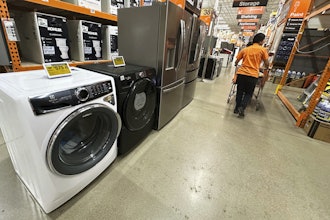
 Graham Grose
Graham GroseA new wave of technologies and an increase in cyber-based attacks are forcing the defense industry to adapt. While defense budgets are under scrutiny in the West, defense spending is increasing dramatically in the Middle East and Asia-Pac regions, opening new markets for growth and opportunity. It truly is an industry in flux. Here Graham Grose, Global Industry Director of Aerospace and Defense at IFS, forecasts the three key trends to impact the defense industry in 2017.
Performance-based Logistics Taking off in the Middle East and Asia-Pac
In 2017 I expect performance-based logistics (PBL), a strategy that optimizes total system availability while minimizing costs and logistics footprint, will deliver huge changes and opportunities for the rapidly growing Middle East and Asia-Pacific defense markets. Saudi Arabia surpassed Russia as the third largest military spender in 2015 while the UAE has now entered the global top 15 spenders. Rising border tensions in Asia-Pac have also been met with increased budgets.
In the past, MoDs in the region have supported local companies with offset agreements to supply spare parts and facilitate the logistics process. However, ME and APAC armed forces are expected to look a step beyond this into higher efficiency and availability in 2017. In fact, we’re already seeing such deals in the region, with the Japan Maritime Self Defense Force (JMSDF) recently signing a PBL deal with Airbus for the maintenance, parts supply and repair of its training helicopters.
PBL Helps Unlock Significant Cost Savings
Organizations in the region are not just being judged on the delivery of military capability and the efficiency and completion of operations any more, but on cost effectiveness too. This comes at a time when many ME and APAC organizations are undergoing significant structural transformation as forces continue to mature and defense budgets increase.
PBL bases decisions on the contractor’s ability to perform maintenance efficiently and cost-effectively. Rather than traditional procurement, there are various flavors of PBL ranging from the ‘spares and repairs’ approach to full contracting for availability.
Australia is already considering the value-proposition of PBL. The Australian MoD is implementing PBL contracts into the Joint Strike Force program. Expect to see more ME and APAC organizations jump on the PBL trend in 2017.
PBL Brings Maintenance ‘at the asset’: Breathing New Life Into Military Equipment
In the past, OEMs would sell or lease an aircraft to the military which would take control and maintain the asset themselves. With PBL, there is much more emphasis on working at the asset itself, but software providers are being helped by new opportunities provided by the Internet of Things (IoT).
IoT-enabled sensors allow for the recording of data in real-time as the asset is still in use and alert engineers on the ground who can prepare for repair work. We’re already there with the F-35. All versions of the fifth-generation fighter include ALIS (Autonomic Logistics Information System), a self-diagnostic solution that alerts maintenance engineers as soon as a fault appears.
And we will see more uses of data collection and analysis techniques such as the Health Usage Monitoring Systems (HUMS) and condition-based maintenance solutions. These reduce unnecessary maintenance, which in turn cuts the total cost of ownership and prolongs the lifespan of the asset — an important aspect as contracts for modern military assets can last up to 25 years or more.
2017: Consumer Technologies Start to Deliver for the Military — Off-site , On-site and On Demand
Damage Limitation: Maintenance Drones for a Closer Inspection
Drones are flying off the shelves in the consumer market, but potential advantages also exist for defense maintenance operations.
Easyjet is already doing this in the commercial space, but the same can be applied in the defense sector to reduce the time and costs associated with the maintenance of assets. The UK Royal Navy is using drones to scan Navy vessels for damage. Due to the size and area of naval ships, inspections now take hours rather than days, with fewer people involved and can even be done while at sea.
In the future, we may even see automated maintenance drones than can pick up on faults or damage and do the repairs themselves without the control of an engineer. Trials of autonomous maintenance drones are already happening in the oil and gas industry, so it won’t be long until this idea becomes a reality in defense.
Virtual Reality & Augmented Reality: Off-site Expertise, On Demand
The U.S. army is already investing in virtual reality for soldier training to improve skills, save costs and boost readiness.
As well as military training, the technology will also improve the way maintenance is carried out. IFS partner XMReality has designed a military version of their augmented reality solution for the Swedish Defense Materiel Administration (FMV) because of the increased efficiency the technology offered organizations in other industries.
The XMReality approach allows for two-way communications between an engineer and a maintenance expert located anywhere in the world and in real-time. For example, an engineer working in the dark can do so using an optical head mounted display (OHMD) to display guidance data and documentation. Images from the device are sent to an expert who can project information back to the engineer for real-time demonstration, helping improve first-time fix rates and decrease the chances of human error.
2017: Physical and Digital Disruption Will Shake up the Defense Industry
Need a Repair? Print a Spare!
3D printing will become a huge disruptor in 2017. No longer just a buzzword, the military are already looking into the potential of printing spare parts and military equipment in-theater to drive down costs and drive up availability.
The A&D sector is set to become one of the biggest contributors to 3D printing’s global revenues, predicted to reach a mammoth $1.4 billion by 2019, producing parts in-house — a development that will completely reshape the relationship between contractors and manufacturers.
Currently, all branches of defense organizations rely on the commercial industry for spare parts and materials. But it won’t be long until the military starts to produce its own. Tier 2/3 suppliers will need to jump on the 3D bandwagon fast, or risk losing business.
Digital Warfare: New Arrivals Will Help Defend Against the Rising Tide of Cyberattacks
Organizations need to be better able and prepared to defend networks and data against sophisticated cyberthreats.
Investment in cybersecurity is growing, with research forecasting $1 trillion will be spent globally on projects in the next 5 years, driven by an increase in attacks and security concerns. But despite increasing investment, traditional security strategies have struggled to defend against sophisticated cyberattacks and protect valuable data, made worse by legacy systems and basic security tools.
Look out in 2017 for a new breed of cybersecurity solutions that offer a forward-looking and holistic approach, with a better view of entire security operations to monitor and react to attacks, and where to focus resources to maximize security while attaining business goals.
New Frontiers
The defense industry is in a state of flux. Budgets are shifting due to increased border tensions, the rising threat of cyberattacks and the transformation of supply chains and support. Defense organizations cannot afford to be caught flat-footed. 2017 will start to see defense organizations continue to realign their strategies to take advantage of disruptive technologies — and further tighten their focus on keeping their assets available and ready for deployment as efficiently as possible.
Graham Grose is Global Industry Director of Aerospace and Defense at IFS.























